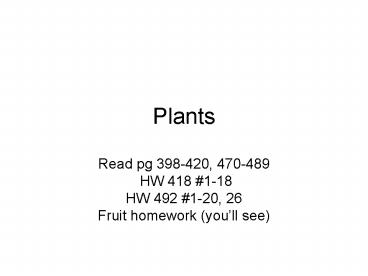Plants - PowerPoint PPT Presentation
1 / 13
Title: Plants
1
Plants
- Read pg 398-420, 470-489
- HW 418 1-18
- HW 492 1-20, 26
- Fruit homework (youll see)
2
Characteristics
- Most plants are green due to their chlorophyll.
- All contain cell walls made of cellulose.
- Plants are autotrophic, producing their own
energy from sunlight. - 2 major categories
- Gymnosperms early seed plants, flowerless
- Angiosperms flowering plants
3
Reviewing cell anatomy
- Unique parts
- Cellulose cell wall
- Large vacuole
- chloroplasts
4
Evolution
- Bryophytes?Seedless vascular plants?gymnosperms?an
giosperms - Bryophytes are small leafy or flat plants that
are evolutionarily the transition between green
algae to vascular plants - Ex some mosses
- Seedless vascular plants are mainly roots
shoots - Ex Ferns
- Gymnosperms produce seeds
- Ex Conifer trees (pine trees)
5
Gross Anatomy
- Major tissues in plants
- Roots, stems, leaves, and sometimes flowers
- Xylem and phloem
- Xylem transports water along a plant stem
- Phloem transports foods/nutrients
- Stoma
- Specialized cells in leaves that open and close
to allow gas exchange.
6
Shoots Roots
- Roots
- Anchor
- Uptake water and minerals/nutrients
- 2 types Tap roots, fibrous roots
- Stems
- Where shoots and buds arise from. Lateral and
vertical expansion of the plant. - Provides support and transfers uptake from roots
to the rest of the plant. - Leaves
- Main food production. Broad structures capture
sunlight. - Often waxy to prevent water loss.
- Flowers are considered specialized shoots.
7
Seeds
- What is a seed?
- A seed is a mature ovule containing an embryo.
- Gymnosperm means naked seed and these are the
first plants to produce seeds evolutionarily. - Pollination is the transference of a male
gametophyte (pollen) to a female gametophyte
(ovule) and fertilization results in a seed.
8
Flowering plants
- Angiosperms belong to the phylum Anthophyta.
- Split into two major categories monocots and
eudicots. - Fruits and seeds use a variety of dispersion
methods - Animals
- Water
- wind
9
Monocot vs Dicot
- Monocots are plants with one cotyledon (or
seed-leaf), triplet flowers, and parallel veins. - Good examples of monocots are
- Grasses
- True grains (rice, wheat, corn)
- Palm trees, banana trees
- Onion family (onion and garlic
- Eudicots are plants with 2 (ditwo) cotyledons,
flowers in multiples of 4/5, and branched veins. - Most other flowering plants are eudicots.
10
2 phase life cycle
- All plants undergo an alternation of generations.
- A switch from diploid (2n) generation to haploid
(n) generation where structures differ.
11
Life Spans
- Another way to classify plants is the length of
time they live - Annuals Plants that live and die in one year or
growing season. Most vegetables and flowers are
annuals. - Biennials These plants complete a lifecycle in 2
years. Carrots, beats, and some flowers are
biennials. - Perennials These plants continue to grow year
after year. Trees are good examples of perennial
plants.
12
Fruits!
- 1. apples,2. oranges,3. peaches,4. bananas,5.
berries - i.e. strawberries, raspberries,
blueberries, etc.6. pears7. any fruit not
listedextras -kiwis, cantaloupes, melons,
papayas, pineapples, red/green peppers, avocados
13
- Other things
- Plant defense
- Special structures (thorns etc)
- Hormones
- Flower structure
- Plant diversity
- Fruit
- Agriculture/human benefits































